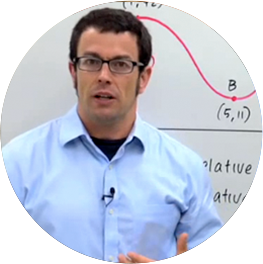
Cornell University
PhD. in Mathematics
Norm was 4th at the 2004 USA Weightlifting Nationals! He still trains and competes occasionally, despite his busy schedule.
Use the chain rule to find the derivative of the composite of two functions--the derivative of the "outside" function multiplied by the derivative of the "inside" function. Thechain ruleis related to theproduct ruleand thequotient rule, which gives the derivative of the quotient of two functions.
I want to talk about
the chain rule.
The chain rule is how we differentiate
composite functions.
Now let me remind you what
composite functions are.
I have three examples here.
Composite functions are basically when you
take one function and stuff it inside another.
Like here, I have the function X squared
plus 3X plus 4 and then I'm taking
that whole function and raising it to the 12th power.
Here, I have 4X squared plus 9 and that's
being put inside the square root function.
And this last function has 2X cubed minus
5 inside the function E to the X.
It's really important to recognize with
composite functions that there
is an inside function and an outside function.
So to highlight those differences between
inside and outside, I've made the
inside functions always blue here.
And the outside functions are always red.
Each of these functions could be expressed
as F of G of X where G of X is sort
of a general name I'm giving
to the inside function.
F of of X is the outside.
How do you differentiate these?
The answer is the chain rule.
This is the chain rule.
So the derivative of F of G of X is going
to be F prime of G of X times G prime
of X. That's the rule we're going to use.
You differentiate the outside function first,
leave the inside function alone,
then multiply by the derivative
of the inside function.
让我们试试那t out on this problem.
H of X is -- it's the first
of our examples over there.
So H prime is going to be -- and according
to this formula I differentiate the
outside function first.
Here the outside function
is something to the 12th.
So the derivative is going to be 12 times
something to the 12 minus 1 or 11.
Now, the inside remains unchanged.
The G of X is unchanged
in this first part.
So I just write X squared
plus 3X plus 4.
But we're not done.
We still have to multiply by the
derivative of the inside part.
This is the inside part.
Its derivative is 2X plus
3. Now we're done.
So this is the chain rule.
You differentiate the outside function first,
leave the inside alone, and then
multiply by the derivative
of the inside function.